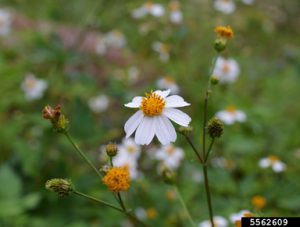Blog by Morgan Pinkerton and Tina McIntyre, UF/IFAS Extension Seminole County
What is a weed?

To understand what an invasive weed is, we must first learn what is a weed! A weed is any plant that is growing where it is not wanted, or competing with desirable plants. Humans decide what a weed is based on where it is growing! A plant can be a weed in one situation and be a desirable plant in another.
For example, Bidens alba, also known as Spanish needle or beggarticks, is sometimes called a weed. Nursery growers work to prevent Bidens alba from growing on their operation. It is also a common plant controlled in yards. However, this plant is an important native wildflower for our pollinators. In natural areas, the growth of Bidens alba is beneficial to our native wildlife.
What problems do weeds cause?
Weeds are unwanted for many different reasons. Weeds can compete with our crops, reducing yields or making it harder to grow or harvest our food. They might also be human or animal health hazards or cause allergic reactions like poison ivy and many others. Some weeds, especially aquatics weeds, can interfere with our natural waterways. Left uncontrolled, weeds can also grow over roads and structures interfering with transportation and daily life. Some plants are weeds because they just don’t look pretty or aesthetically fit in with nearby plants. Regardless of the problems they are causing, all weeds have in common that they are unwanted for one reason or another.
What is an invasive weed?

An invasive species is any organism that is outside its native range and causes damage in the new area. Invasive weeds can be more problematic than native weeds as they can displace native species and disrupt local ecosystems.
Many invasive weeds grow and reproduce quickly, and can be difficult to get rid of. In a plant’s native range, it may have wildlife that eat it, pathogens that kill it, or other things that keep it from growing out of control. Once introduced to a new area, a non-native species might lack things naturally controlling the plant’s population, so it can thrive in the introduced range.
In Florida, we are already combating many invasive plant species. For example, air potato (Dioscorea bulbifera), hydrilla (Hydrilla verticillata), water hyacinth (Eichhornia crassipes), and Brazilian peppertree (Schinus terebinthifolia) have all been problematic in recent years.
How do invasive plants spread?
Plants can’t just get up and walk like we can. So how do they spread? There are many ways invasive plants can spread either naturally or artificially.
Natural spread
Plants can grow, but this movement is very slow! You definitely won’t see a plant reaching an area 1000 miles away just by growing, so this movement is just a short distance over time.
Over longer distances, plants can spread by seed or other reproductive structures. Wind and water commonly move seeds to new areas. Animals can move seeds around too. Some seeds can hitchhike such as by sticking to an animal’s fur and falling off in a new location. Animals, such as birds, can eat fruit containing seeds and later, after digestion, the animal poops out the seeds in a new location.
Human assisted movement
Very often, humans move around invasive plant species, sometimes without even knowing it! Just like seeds can hitchhike on animals, seeds can catch a ride on humans or objects that we move around. Seeds might get stuck on your clothes or on equipment, and then fall off in new areas. For example, seeds can stick to a lawn mower in one yard and then fall off when the mower is used at another location. Seeds of invasive species could also be mixed in with other seeds and when we plant a packet of seeds, the invasive species gets planted too. Seeds or other reproductive structures might be in soil so when we move soil, we can move these invasive species with it.
Humans may also intentionally introduce plant species to new areas where they become invasive. Humans often bring plants to new areas because they like them. The invasive plant may be really pretty as an ornamental plant or even be a food or forage crop. For example, if you find a really cool plant from another part of the world at a plant sale, plant it in your backyard, and then a few years later, it is taking over all your other plants, you might have planted an invasive species. Today, we live in a globalized world where goods and people are moving around the globe at a faster rate than ever before. This also increases the chances of introducing invasive species to new areas. For this reason, it is important to know what you are buying. Make sure you aren’t planting invasive species and furthering their spread!
Interested in participating in Weed Wrangle© Week 2021?
Check out this article for more information on what is going on locally this week. Be sure to catch all the other cool resources we are sharing this week on our Central Florida CISMA Facebook page!
More Resources
- Central Florida Cooperative Invasive Species Management Area
- Florida Invasive Species Partnership
- Florida First Detector Program
- Invasive Weeds EDIS Documents
- UF Center for Aquatic and Invasive Plants
- WeedWrangle.org
 0
0
